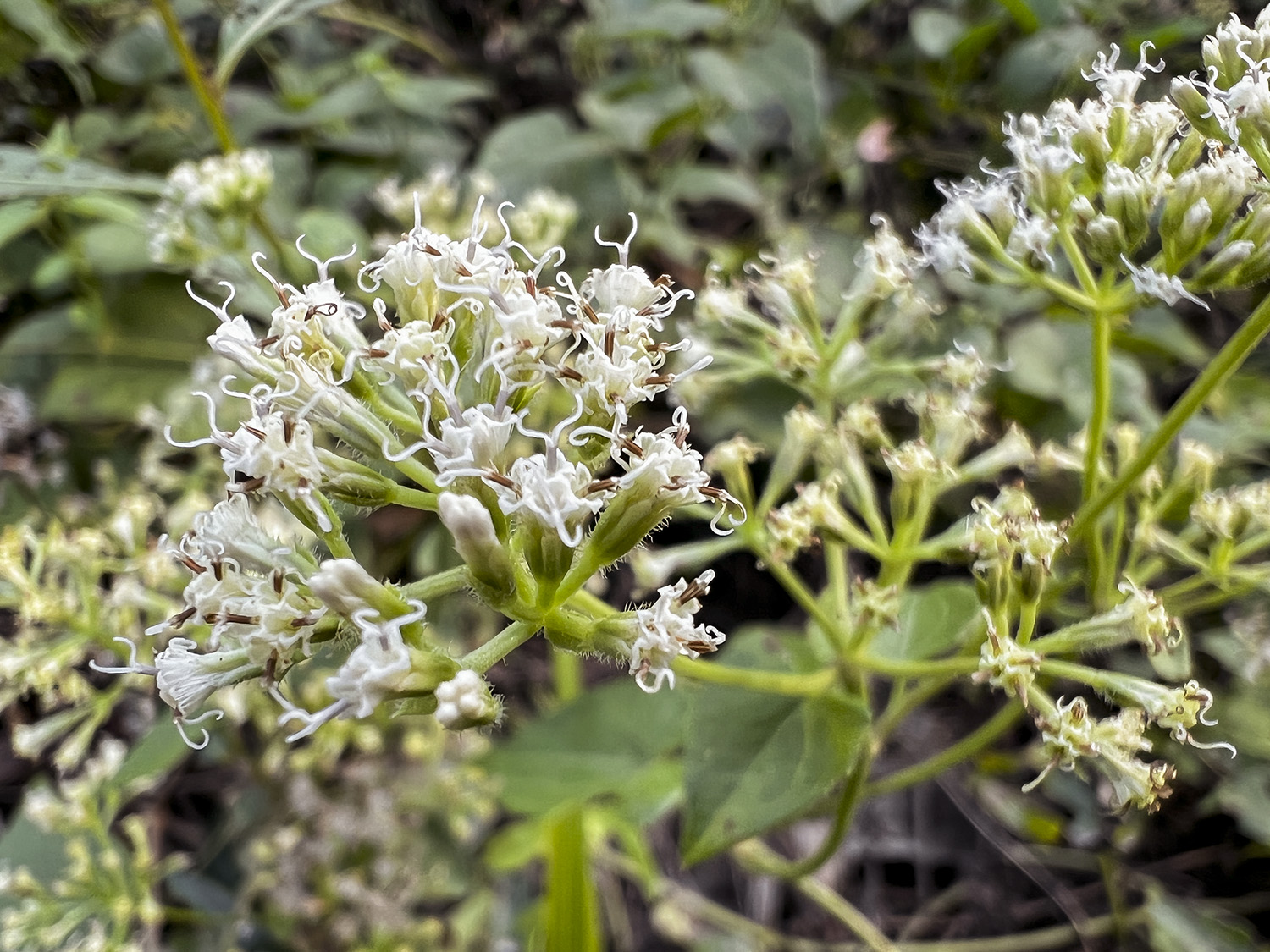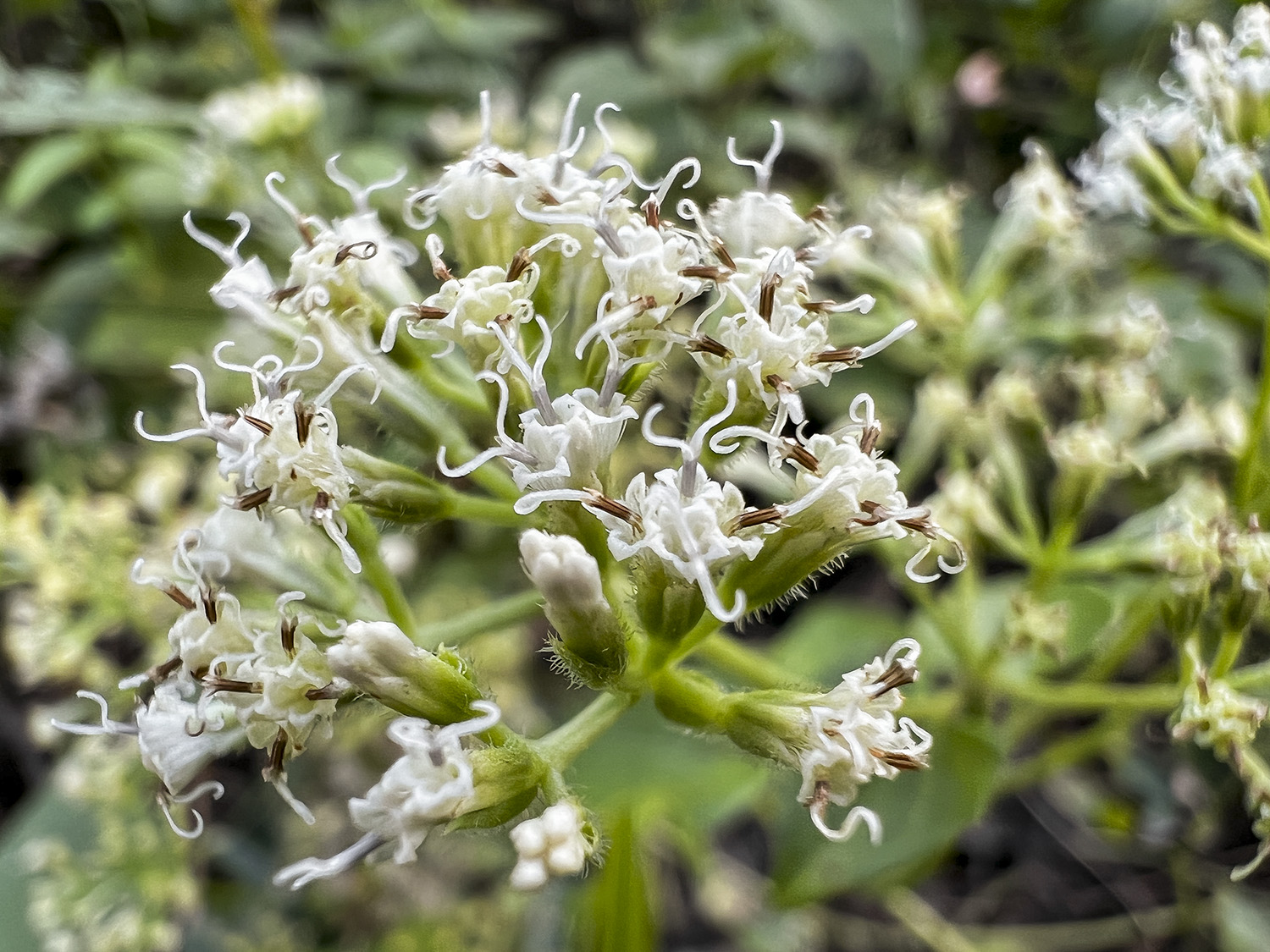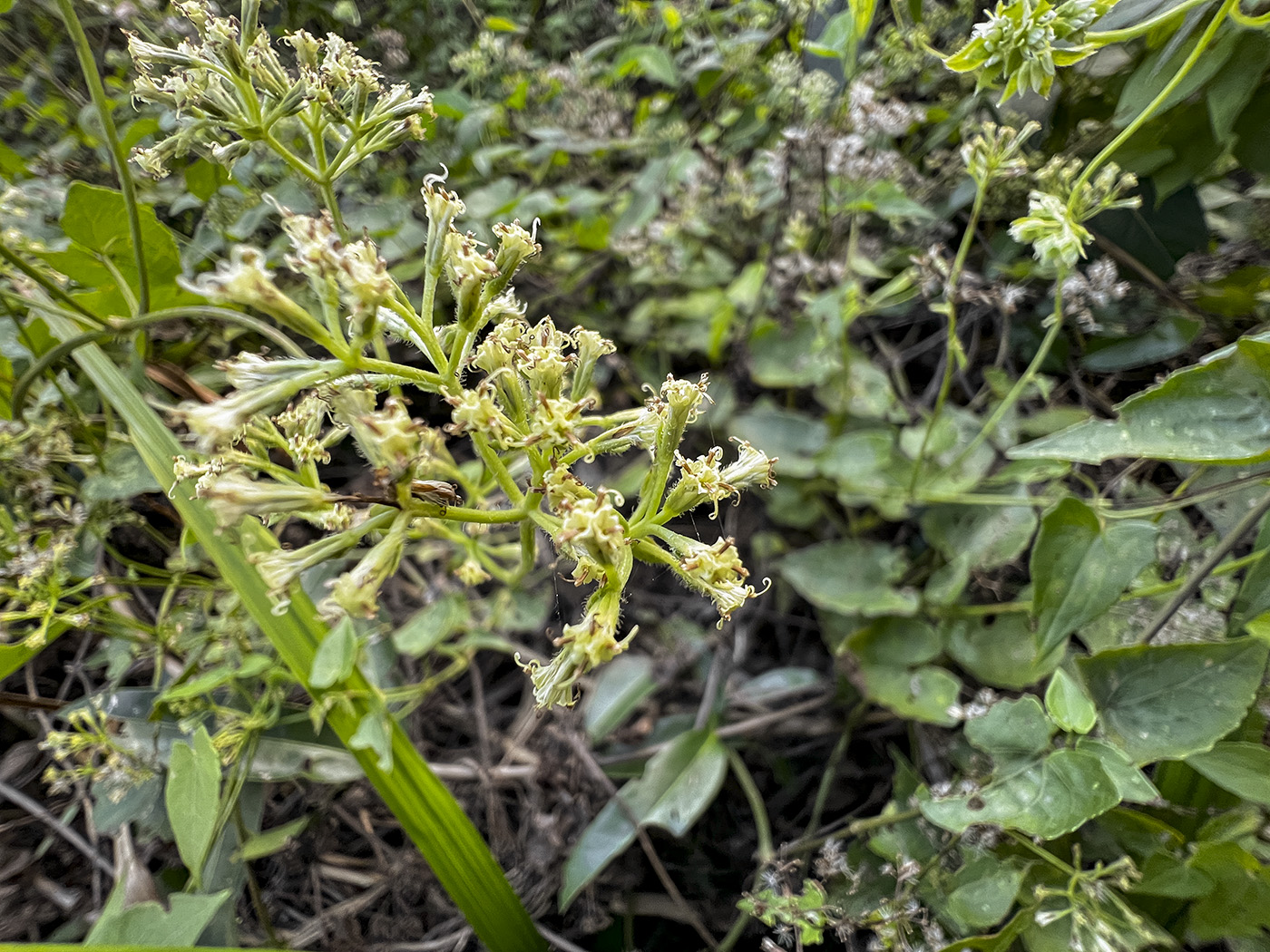Mikania micrantha is one of the species we photographed in Paso Caballos, part of our last expedition in Peten. We are studying this species in Guatemala and are curious why no one lists this one species as edible, meanwhile elsewhere Americas mention the fruits and leaves edible of different species of Mikania
Pagad (2005) Mikania micrantha is a perennial creeping climber known for its vigorous and unrestrained growth. It grows best where fertility, organic matter, soil moisture, and humidity are high. It damages or kills other plants by cutting off light and suffocating them. Native to Central and South America. It is one of the most widespread and troublesome weeds in the Pacific region. Its seeds are dispersed by the wind.
Botanical description:
A branched, slender-stemmed perennial vine. The leaves are arranged in opposite pairs along the stems and are heart-shaped or triangular with an acute tip and a broad base. Leaves may be 4-13cm long. The flowers, each 3-5mm long, are arranged in dense terminal or axillary corymbs. Individual florets are white to greenish-white. The seed is black, linear-oblong, five-angled and about 2mm long. Each seed has a terminal pappus of white bristles that facilitates dispersal by wind or on the hair of animals (Pacific Island Ecosystems at Risk).
Mikania scandes can be confuse with Mikania micrantha, but there are some differences you can keep in mind: The inflorescence is habitually looser and more paniculate in M. micrantha than in M. scandens; the inflorescence in M. scandens is mostly crowded with round-topped corymbs. The phyllaries (bracts) of the heads are acute in M. micrantha rather than attenuate as in M. scandens. M. micrantha seems never to show the purplish coloration which is nearly always present in M. scandens. Although the leaves vary greatly in contour both in M. scandens and in M. micrantha, they tend on the whole to be more sharply angled and triangular-sagittate or -hastate in M. scandens and more oval, cordate, and merely crenate in M. micrantha" (Holm et al., 1977; p. 322).
PDF, Articles, Books on Mikania micrantha
- 2012
- Which Mikania: Native Vine or Noxious Weed? Florida Department of Agriculture and Consumer Services and Consumer Services. Division of Plants Industry. Botany Circular No. 37.
Request full-text:
www.researchgate.net/publication/280133452_Which_Mikania_Native_vine_or_noxious_weed
- 2008
- Potential biological control agents for Mikania micrantha hbk from the Neotropical region. Tropical Pest Management, Vol. 28, Issue 3.
Available online:
www.tandfonline.com/doi/abs/10.1080/09670878209370717?journalCode=ttpm19
- 2010
- Mikania cordifolia y Mikania micrantha (Asteraceae): especies medicinales nativas de las reservas naturales de Punta Lara e Isla Martín García, Buenos Aires, Argentina. SEDICI.
Downloadable online:
http://sedici.unlp.edu.ar/handle/10915/2664
- 2013
- Antispasmodic effects of Mikania micrantha Kunth and dual gastrointestinal effect of Mikania cordifolia (L.F.) Willd (asteraceae) on isolated rat thin intestine. Pharmacology online, Vol. 2, No. 1, 11 pages.
Downloadable online:
https://pharmacologyonline.silae.it/files/archives/2013/vol2/PhOL_2013_2_A001_001_Colares.pdf
- 2017
- Phenolics from Mikania micrantha and Their Antioxidant Activity. Molecules.
Downloadable online:
www.mdpi.com/1420-3049/22/7/1140
- 2014
- The anti-tumor activity of Mikania micrantha aqueous extract in vitro and in vivo. Cytotechnology, Vol. 66, pages107–117.
Downloadable online:
www.ncbi.nlm.nih.gov/pmc/articles/PMC3886538/
- n.d.
- Mikania micrantha. Mile-a-minute weed
Downloadable online:
www.fao.org/forestry/13376-05d702161c15b1e3defa6bf9c8e6c4f82.pdf
- 1993
- Effects of Mikania micrantha H.B.K. on germination and growth of weed species. Plant and Soil, Vol. 157, pages 107–113.
Available online:
https://link.springer.com/article/10.1007/BF00038753
- 2015
- Antidermatophytic Activity of Mikania micrantha Kunth: An Invasive Weed. Pharmacognosy Research, Vol. 7, Supplement 1.
Downloadable online:
www.ncbi.nlm.nih.gov/pmc/articles/PMC4466764/pdf/PR-7-20.pdf
- 2015
- Phytochemical investigation, antioxidant activity and antihelmintic activity of Mikania micrantha leaves.
Downloadable online:
www.researchgate.net/publication/275769290_Phytochemical_Investigation
_Antioxidant_Activity_and_Anthelmintic_Activity_of_Mikania_Micrantha_Leaves
- 2013
- Antimicrobial Constituents of the Leaves of Mikania micrantha H. B. K. Plos One, Vol. 8, Issue 10.
Downloadable online:
www.ncbi.nlm.nih.gov/pmc/articles/PMC3788719/pdf/pone.0076725.pdf
- 2009
- Mile-A-Minute (Mikania micrantha): A New Weed in South Florida.
Downloadable online:
https://edis.ifas.ufl.edu/pdf/AG/AG33800.pdf
- 2005
- Seed germination eco-physiology of Mikania micrantha H.B.K. Bot. Bull. Acad. Sin., Vol. 46, pages 293-299.
Available online:
https://ejournal.sinica.edu.tw/bbas/content/2005/4/Bot464-02.html
Suggested web pages
with photos and information on Mikania micrantha
www.cabi.org/isc/datasheet/34095
Complete information.
www.hear.org/pier/species/mikania_micrantha.htm
Botanical description, general information and photos.
http://issg.org/database/species/ecology.asp?si=42&fr=1&sts=&lang=EN
Complete information and photos.
First posted February, 2022
Bibliography prepared by FLAAR MESOAMERICA
















































































